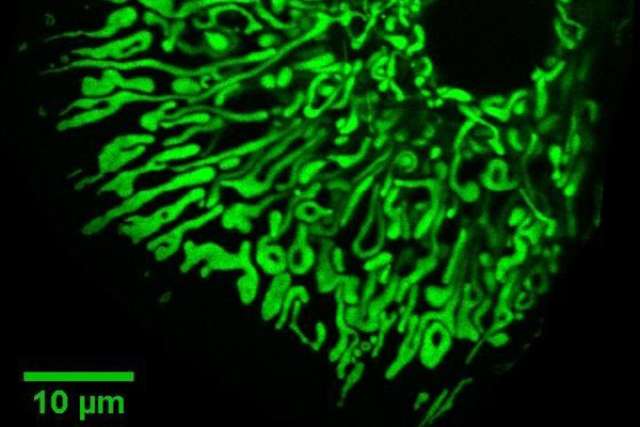FINDINGS
A new multi-institution study led by a team of researchers at the David Geffen School of Medicine demonstrated that blocking a protein called ABCB10 in liver cells protects against high blood sugar and fatty liver disease in obese mice. Furthermore, ABCB10 activity prompted insulin resistance in human liver cells.
The findings are the first to show that ABCB10 transports biliverdin out of the mitochondria – the cell's "energy generating powerhouses." Biliverdin is the precursor of bilirubin, a substance with antioxidant properties. Consequently, ABCB10 transport activity causes an increase in bilirubin synthesis inside liver cells undergoing fatty liver disease.
BACKGROUND
Non-alcoholic fatty liver disease is closely linked to obesity and other disorders related to insulin resistance and is becoming increasingly common throughout the world, affecting an estimated 100 million people in the United States.
The liver filters everything that people consume and sorts it for the nutrients that will stay in the body or for the toxins that it will expel. The liver is also one of the organs richest in mitochondria – the small organelles in cells that convert food into usable energy through a process called metabolism. Consequently, the mitochondria produce high levels of free radicals, as well as antioxidants to keep these free radicals at healthy levels. Both free radicals and antioxidants play a key role in regulating metabolism and are elevated in insulin resistance and fatty liver disease.
One of these antioxidants is bilirubin, a yellow-bile substance that is released from the breakdown of biliverdin – its green-bile precursor. Bilirubin is produced at high levels in livers from people with fatty liver disease. Both biliverdin and bilirubin are found naturally in the body and released during the breakdown of heme – the deep red iron-containing molecule in red blood cells, which can be seen in the changing color of bruises – from green (biliverdin) to yellow (bilirubin).
Previous research established that mild increases in blood bilirubin content could be associated with protection from metabolic diseases. However, the effects of bilirubin content inside mitochondria and their relationship to fatty liver disease and insulin resistance, remained unknown. This current study shows that increased bilirubin content inside the mitochondria driven by ABCB10 activity is contributing to fatty liver disease.
METHODS
In the study, the researchers removed the ABCB10 protein selectively from the livers of mice to test whether ABCB10 removal impacted the ability of obese mice to tolerate glucose, if they developed fat in the liver and how well the mitochondria in their livers were working to convert nutrients into usable energy.
In lean mice, the researchers found no difference in metabolism and health when ABCB10 was removed from their livers, while in obese mice they found that removing ABCB10 protected against insulin resistance and fatty liver disease.
Secondly, the researchers measured bilirubin in the mitochondria of liver cells using fluorescent sensors, as well as testing purified ABCB10 to determine what ABCB10 transports. They found that ABCB10 transports biliverdin out of the mitochondria and increases bilirubin production in liver cells, with ABCB10 removal decreasing mitochondrial bilirubin content to levels observed in lean mice.
Thirdly, the researchers found that when they restored bilirubin content in the mitochondria, the benefits on the function of mitochondria resulting from the removal of ABCB10 were reversed.
IMPACT
These findings shed light on the relevance of the association of some genetic ABCB10 variants with insulin resistance in Type 2 diabetes. While still very early to draw any conclusions, these findings could inspire the development of therapies that target ABCB10 or mitochondrial bilirubin in the liver to reverse fatty liver disease in obese individuals.
JOURNAL
The study is published in the May 19 issue of Science Translational Medicine.
DOI: 10.1126/scitranslmed.abd1869
AUTHORS
The senior author of the study is Dr. Marc Liesa and the first author is Dr. Michael Shum, both in the Department of Medicine, Division of Endocrinology; the Department of Molecular and Medical Pharmacology at the David Geffen School of Medicine at UCLA. Additional study authors include Vincent Gutierrez of the Medical Scientist Training Program (MSTP) at UCLA and Drs.' Thorsten Althoff and Jeff Abramson from the Department of Physiology at UCLA; Drs.' Chitra A. Shintre and Liz Carpenter from the University of Oxford; Alexandra Saxberg, Melissa Martinez and Dr. Maria Zoghbi from the University of California, Merced; as well as researchers from Boston University School of Medicine; and the University of Cincinnati College of Medicine.



